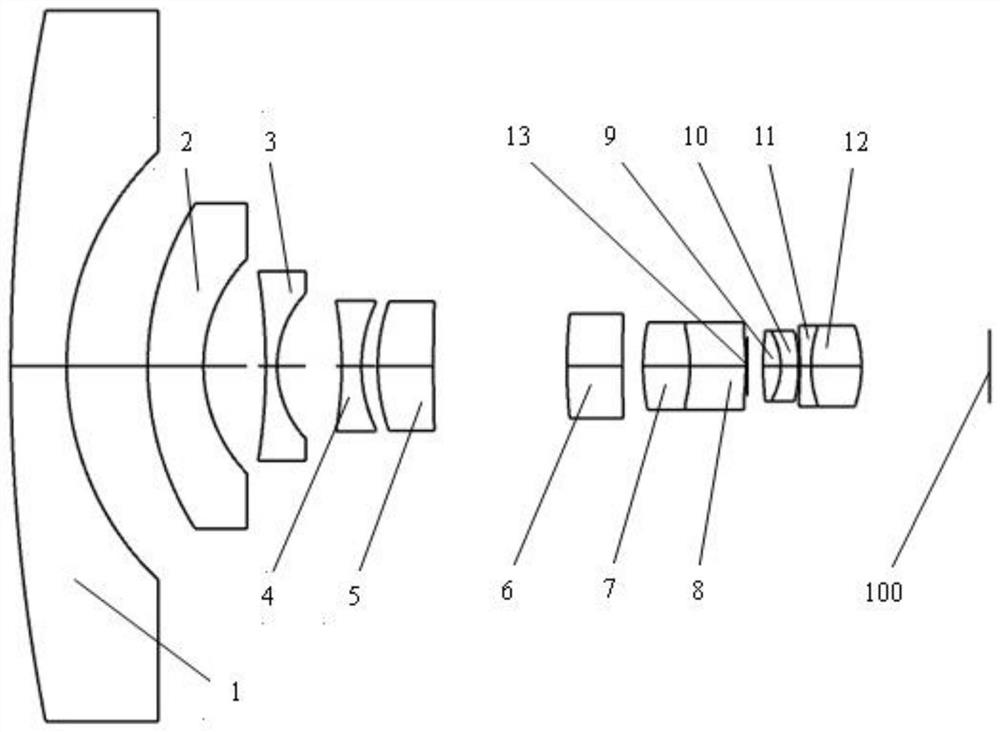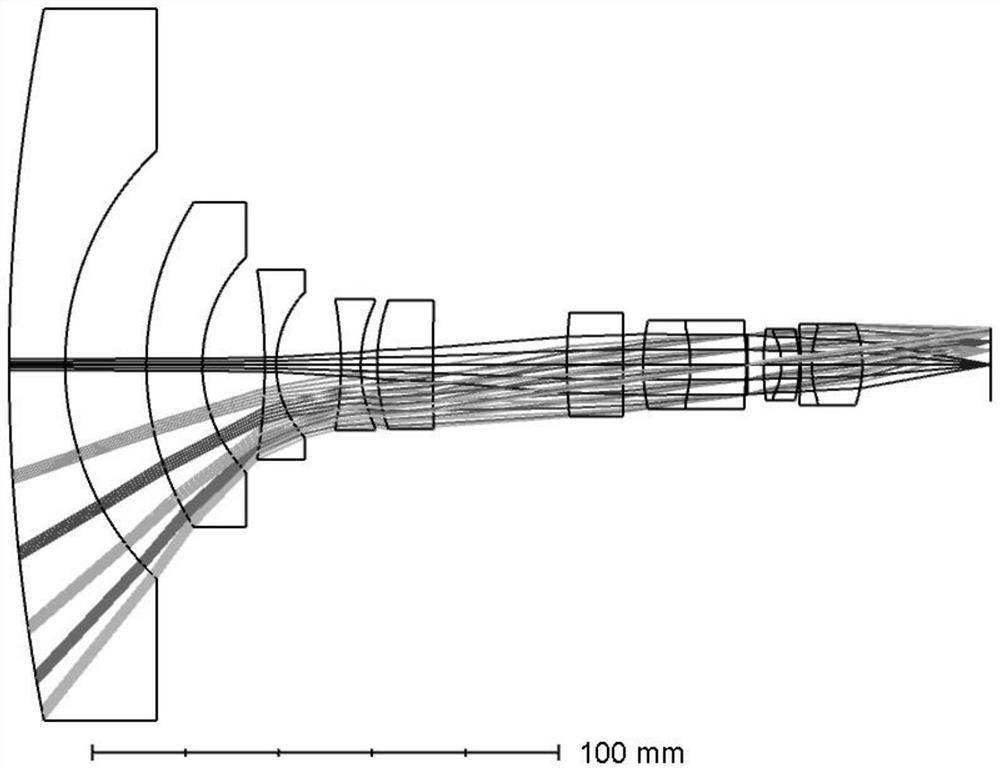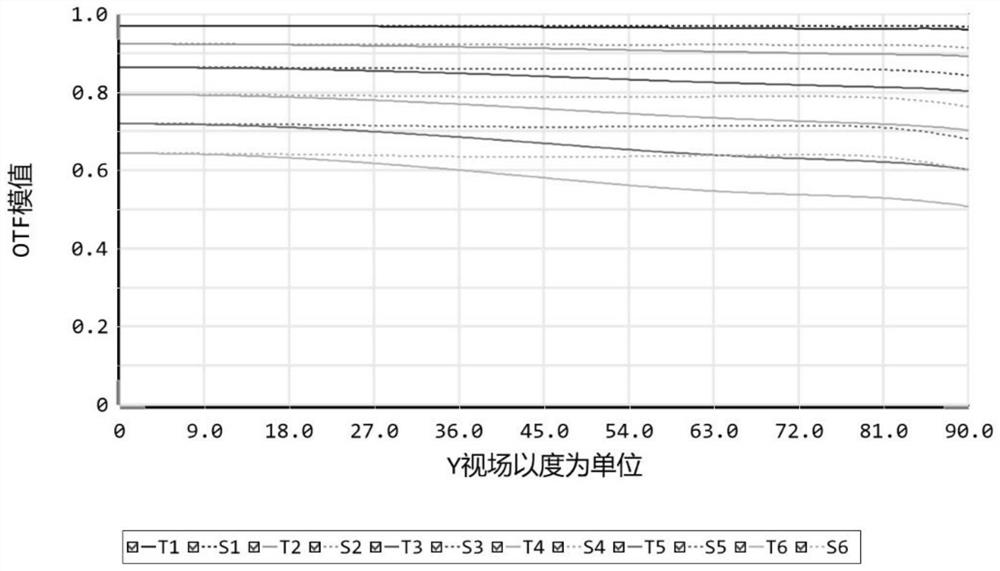Large-view-field hemispherical airspace fisheye lens system
An airspace fish and eye lens technology, applied in optical components, optics, instruments, etc., can solve the problem of loss of real-time information and achieve an effect that is beneficial to processing
- Summary
- Abstract
- Description
- Claims
- Application Information
AI Technical Summary
Problems solved by technology
Method used
Image
Examples
Embodiment 1
[0026] In this example, see figure 1 , a large field of view hemispherical space fisheye lens system, along the direction of the optical axis, from the object side to the image side, sequentially includes a front lens group with negative refractive power and a rear lens group with positive refractive power;
[0027] The front lens group sequentially includes a first lens (1) with negative refractive power, a second lens (2) with negative refractive power, and a second lens (2) with negative refractive power in the direction of the optical axis from the object side to the image side. Three lenses (3), a fourth lens (4) with negative power and a fifth lens (5) with positive power;
[0028] The rear lens group sequentially includes a sixth lens (6) with positive refractive power, a seventh lens (7) with positive refractive power, and an eighth lens with negative refractive power in the direction of the optical axis from the object side to the image side Lens (8), aperture stop (...
Embodiment 2
[0031] This embodiment is basically the same as Embodiment 1, especially in that:
[0032] In this embodiment, the seventh lens (7) and the eighth lens (8) are combined into a doublet lens by cementing.
[0033] In this embodiment, the ninth lens (9) and the tenth lens (10) are combined into a doublet lens by cementing.
[0034] In this embodiment, the eleventh lens (11) and the twelfth lens (12) are combined into a doublet lens by cementing.
[0035] In this embodiment, the field angle of the lens of the system is 180°±5°, the total focal length is 6.740mm±0.1mm, the F number is 2.8±0.05, the total length is 210.36mm±5mm, and the detectable wavelength range It is 486-656nm, and the dominant wavelength is 588nm±10nm.
[0036] In this embodiment, the fisheye lens system with large field of view and hemispheric space balances the aberration of the front lens group and the aberration of the rear lens group as much as possible, so that the imaging quality meets the requirements....
Embodiment 3
[0038] This embodiment is basically the same as the above-mentioned embodiment, and the special features are:
[0039] In this embodiment, the lens of the system has an angle of view of 180°, a total focal length of 6.740 mm, an F number of 2.±0.05, a total length of 210.36 mm, a detectable wavelength range of 486-656 nm, and a dominant wavelength 588nm.
[0040] The first lens 1, the second lens 2, the third lens 3, the fourth lens 4, the fifth lens 5, the sixth lens 6, the seventh lens 7, the eighth lens 8, the first lens The materials of the nine lenses 9, the tenth lens 10, the eleventh lens 11 and the twelfth lens 12 are respectively H-K9L, H-K9L, H-K9L, H-ZK9B, ZF4, ZF1, H- KF6, H-ZBAF52, H-K10, H-ZLAF52, H-ZF3, H-K9L.
[0041] The first lens 1, the second lens 2, the third lens 3, the fourth lens 4, the fifth lens 5, the sixth lens 6, the seventh lens 7, the eighth lens 8, the first lens The refractive indices n of the nine lenses 9, the tenth lens 10, the eleventh l...
PUM
| Property | Measurement | Unit |
|---|---|---|
| Field of view | aaaaa | aaaaa |
| Total length | aaaaa | aaaaa |
Abstract
Description
Claims
Application Information
 Login to View More
Login to View More - R&D
- Intellectual Property
- Life Sciences
- Materials
- Tech Scout
- Unparalleled Data Quality
- Higher Quality Content
- 60% Fewer Hallucinations
Browse by: Latest US Patents, China's latest patents, Technical Efficacy Thesaurus, Application Domain, Technology Topic, Popular Technical Reports.
© 2025 PatSnap. All rights reserved.Legal|Privacy policy|Modern Slavery Act Transparency Statement|Sitemap|About US| Contact US: help@patsnap.com



